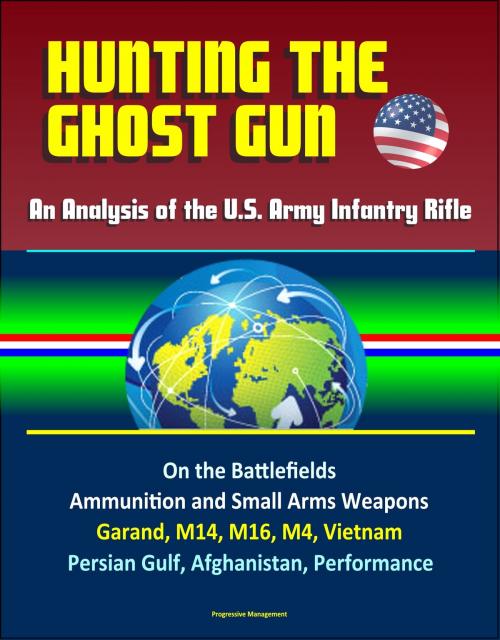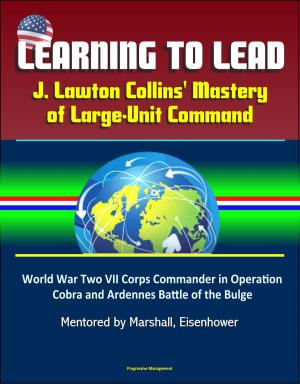Hunting the Ghost Gun: An Analysis of the U.S. Army Infantry Rifle - On the Battlefields, Ammunition and Small Arms Weapons, Garand, M14, M16, M4, Vietnam, Persian Gulf, Afghanistan, Performance
Nonfiction, History, Military, Weapons| Author: | Progressive Management | ISBN: | 9781370357567 |
| Publisher: | Progressive Management | Publication: | October 23, 2016 |
| Imprint: | Smashwords Edition | Language: | English |
| Author: | Progressive Management |
| ISBN: | 9781370357567 |
| Publisher: | Progressive Management |
| Publication: | October 23, 2016 |
| Imprint: | Smashwords Edition |
| Language: | English |
This excellent report has been professionally converted for accurate flowing-text e-book format reproduction. Like many other nations, the United States was born of war. The freedom sought by our founding fathers was not free; it was paid in patriot blood during the American Revolution. No matter the reason—the preservation of democracy, liberation of the oppressed, or revolution—the United States has been no stranger to the battlefield. Through deserts, jungles, and grassy plains; in brick buildings, straw huts, and log cabins; by mountains, ditches, and the oceans, the infantry soldier has relied on one key tool to accomplish the mission: his weapon. Indeed, among the many characteristics of war, the infantry rifle has remained a critical battle component throughout time.
The purpose of this study is to provide an analysis of the U.S. military's usage of various small arms and their associated cartridges from WWII to current day. The primary objective centers on an analysis of the driving factors and decisions used in military cartridge selection and development. The expected product will be a reference document to aid in the decision-making process for future small arms cartridge/weapon selection and development.
Chapter I: This chapter provides general information, objectives, scope, methodology, benefits, and the organization of the study. Chapter II: This chapter establishes a baseline of terms used in this study. This chapter provides a brief technical background of projectiles, cartridges, and U.S. small arms types. The terms and concepts in this chapter are also used in the analysis portions of subsequent chapters. Chapter III: This chapter is separated into three sections and briefly describes the history of the U.S. Service Rifle from WWII to Afghanistan. The first discusses infantry weapons and ammunition during the Second World War as well as during the Korean War. The first segment focuses on the impact made by the M1 rifle. The second segment discusses infantry weapons and ammunition during the Vietnam War. The second segment focuses on the impact made by the M16 and M14 rifles. The third segment discusses infantry weapons and ammunition during the Persian Gulf War and the war in Afghanistan. The third segment focuses on the impact made by the M4 carbine. Chapter IV: This chapter will compare and contrast the Infantry weapon/cartridge capabilities against the actual battlefield requirements during the time periods discussed in Chapter III. The comprehensive analysis seeks to reveal whether or not the U.S. Army has provided its infantry with the optimum cartridge and weapon throughout history. Chapter V: This chapter provides an opportunity to draw conclusions and afford options for improved decision making during the U.S. Army's evolution of the infantry weapon and ammunition programs.
CHAPTER I - INTRODUCTION * A. GENERAL INFORMATION * B. OBJECTIVE * C. SCOPE * D. METHODOLOGY (COMPARATIVE ANALYSIS) * E. BENEFITS OF THE STUDY * F. ORGANIZATION OF THE STUDY * CHAPTER II - AMMUNITION AND SMALL ARMS WEAPONS * A. AMMUNITION * B. U.S. SMALL ARMS WEAPONS * C. DISCUSSION * CHAPTER III - INFANTRY RIFLES ON THE BATTLEFIELDS * A. EUROPE AND THE GARAND * 1. Background * 2. Discussion. * B. SOUTHEAST ASIA, THE M14, AND THE M16 * 1. Background * 2. Discussion * C. THE PERSIAN GULF, AFGHANISTAN, AND THE M4 * 1. Background * 2. Discussion. * CHAPTER IV - ANALYSIS * A. EUROPE * 1. Weapon Type and Design * 2. Ammunition Caliber and Design * 3. System Performance * B. SOUTHEAST ASIA * 1. Weapon Type and Design * 2. Ammunition Caliber and Design * 3. System Performance * C. THE PERSIAN GULF AND AFGHANISTAN * 1. Weapon Type and Design * 2. Ammunition Caliber and Design * 3. System Performance * CHAPTER V - CONCLUSION
This excellent report has been professionally converted for accurate flowing-text e-book format reproduction. Like many other nations, the United States was born of war. The freedom sought by our founding fathers was not free; it was paid in patriot blood during the American Revolution. No matter the reason—the preservation of democracy, liberation of the oppressed, or revolution—the United States has been no stranger to the battlefield. Through deserts, jungles, and grassy plains; in brick buildings, straw huts, and log cabins; by mountains, ditches, and the oceans, the infantry soldier has relied on one key tool to accomplish the mission: his weapon. Indeed, among the many characteristics of war, the infantry rifle has remained a critical battle component throughout time.
The purpose of this study is to provide an analysis of the U.S. military's usage of various small arms and their associated cartridges from WWII to current day. The primary objective centers on an analysis of the driving factors and decisions used in military cartridge selection and development. The expected product will be a reference document to aid in the decision-making process for future small arms cartridge/weapon selection and development.
Chapter I: This chapter provides general information, objectives, scope, methodology, benefits, and the organization of the study. Chapter II: This chapter establishes a baseline of terms used in this study. This chapter provides a brief technical background of projectiles, cartridges, and U.S. small arms types. The terms and concepts in this chapter are also used in the analysis portions of subsequent chapters. Chapter III: This chapter is separated into three sections and briefly describes the history of the U.S. Service Rifle from WWII to Afghanistan. The first discusses infantry weapons and ammunition during the Second World War as well as during the Korean War. The first segment focuses on the impact made by the M1 rifle. The second segment discusses infantry weapons and ammunition during the Vietnam War. The second segment focuses on the impact made by the M16 and M14 rifles. The third segment discusses infantry weapons and ammunition during the Persian Gulf War and the war in Afghanistan. The third segment focuses on the impact made by the M4 carbine. Chapter IV: This chapter will compare and contrast the Infantry weapon/cartridge capabilities against the actual battlefield requirements during the time periods discussed in Chapter III. The comprehensive analysis seeks to reveal whether or not the U.S. Army has provided its infantry with the optimum cartridge and weapon throughout history. Chapter V: This chapter provides an opportunity to draw conclusions and afford options for improved decision making during the U.S. Army's evolution of the infantry weapon and ammunition programs.
CHAPTER I - INTRODUCTION * A. GENERAL INFORMATION * B. OBJECTIVE * C. SCOPE * D. METHODOLOGY (COMPARATIVE ANALYSIS) * E. BENEFITS OF THE STUDY * F. ORGANIZATION OF THE STUDY * CHAPTER II - AMMUNITION AND SMALL ARMS WEAPONS * A. AMMUNITION * B. U.S. SMALL ARMS WEAPONS * C. DISCUSSION * CHAPTER III - INFANTRY RIFLES ON THE BATTLEFIELDS * A. EUROPE AND THE GARAND * 1. Background * 2. Discussion. * B. SOUTHEAST ASIA, THE M14, AND THE M16 * 1. Background * 2. Discussion * C. THE PERSIAN GULF, AFGHANISTAN, AND THE M4 * 1. Background * 2. Discussion. * CHAPTER IV - ANALYSIS * A. EUROPE * 1. Weapon Type and Design * 2. Ammunition Caliber and Design * 3. System Performance * B. SOUTHEAST ASIA * 1. Weapon Type and Design * 2. Ammunition Caliber and Design * 3. System Performance * C. THE PERSIAN GULF AND AFGHANISTAN * 1. Weapon Type and Design * 2. Ammunition Caliber and Design * 3. System Performance * CHAPTER V - CONCLUSION















